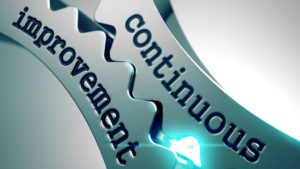Ten Steps To Continuous Improvement
Have you ever walked into a local business and seen something that lacks professionalism? Then did you ask yourself, I wonder why they don’t improve that? Ever shown up at work, noticed an established process and thought, why do we do it this way?
If so, you may have a maximizer strength like me. I’m always seeing things that could be better. Some call it the spiritual gift of criticism so I always try to put a positive spin on it.
 My church has a staff value of “Make It Better.” They are continually in the process of dreaming, creating, implementing, observing, and making improvements.
My church has a staff value of “Make It Better.” They are continually in the process of dreaming, creating, implementing, observing, and making improvements.
If you’re always evaluating present realities, envisioning improvements and coming up with ideas on how to make it better, consider incorporating these ten steps of the continuous improvement cycle.
Idea
Everything ever invented, designed or created began with an idea. Ideas usually originate from a problem. Someone notices a problem and they say, wouldn’t it be great if… An idea is the first step in the continuous improvement cycle.
Plan
Someone said an idea without a plan is just a daydream. Ideas need plans before they can progress and become something more. Plans are extremely important. They can take time. But a well thought out plan is crucial for continuous improvement.
Prepare
Once the plan has been completed, you may be tempted to move right into implementation. But before that, you need to prepare. Preparation is a key step in the process. Prepare yourself. Prepare your audience. Prepare those this plan will affect. Preparation will help the execution go smoothly.
Execute
Once the plan is complete and the preparations have been made, the project can now be executed. The better the plan and preparation were, the more likely the execution will be successful. Many think that the execution phase is the final step. But it’s not. The execution is only the half-way point.
Observe
As the plan is being executed, continuous improvement calls for observation. But don’t allow the person in charge of execution be the observer. The observer needs to be impartial and not subordinate to the executor. Their unbiased observations will serve as a foundation to the next steps in the process.
Measure Results
Each event, every program and all initiatives should have a predetermined goal. Many church programs have undefined goals and the measure of success is based on attendance and the busyness of those involved in the planning and execution. Part of your plan should include the goal of the endeavor. And part of the preparation should include a process for measuring results.
Interpret Data
Once the results are measured, the data needs to be studied and then interpreted. You may receive contradictory feedback like, the music was too loud, and the music was too quiet. This requires interpretation. Unique outliers like these should be considered within the context of the whole. The key to effectively interpreting data is to look for reoccurring themes. Take those themes and boil them down to concise, actionable suggestions for improvement.
Provide Feedback
The observations and the summary of the interpreted data need to be clearly communicated to those in charge. This takes courage and grace because of the emotions attached to the hard work that went into the planning and execution. But if everyone on the team agrees on the Make It Better value, it’s easier to put aside personal feelings for the sake of the greater goal of continuous improvement, accept the feedback and consider the recommendations.
Adjust
Once the feedback has been delivered and received, those in charge can now make the needed adjustments. These adjustments can be small tweaks to the original plan, a modification of one step or a major overhaul of the entire thing. But if no adjustments are made, the whole process was a waste of time.
New Idea
The adjustments that are made ultimately lead to a new, better idea. And the whole process can begin again. Envision it as a loop, starting with the idea, and ending with the new idea. So, implement this process, agree to the Make It Better value, and watch your programs and initiatives become more effective and achieve your desired results.
 Previous Post
Previous Post Next Post
Next Post